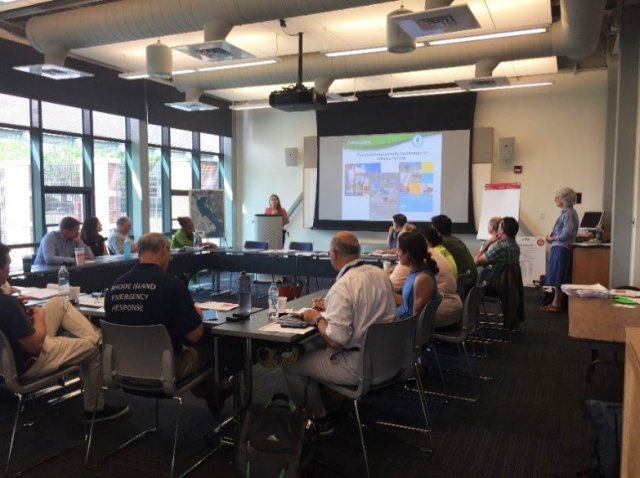Providence Community-Port Collaboration Pilot Project
- Community-Port
Collaboration Pilot Projects - New Orleans
Pilot Project - Providence
Pilot Project - Savannah
Pilot Project - Seattle
Pilot Project
In 2017, EPA selected the Port of Providence (ProvPort), the City of Providence, the Environmental Justice League of Rhode Island (EJLRI), community stakeholders and other interested local entities to receive EPA technical assistance and pilot a draft Community-Port Collaboration Toolkit. This pilot project was one of four pilots that were collectively known as the Near-Port Community Capacity Building Project. Together these local partners aimed to develop a multi-stakeholder working group to facilitate long-term conversation between near-port residents, businesses, government agencies and port-related stakeholders. This page provides an overview of the pilot project. For more information, go to Case Study: Providence Pilot (PDF)(4 pp, 543 K, EPA-420-F-21-025, April 2021)
Technical Assistance

EPA conducted a needs assessment via phone and in-person interviews with a wide range of stakeholders. Key documents related to port, agency, and community initiatives were also reviewed. The needs assessment helped the project team better understand community, port business, and other stakeholder priorities. Additionally, the assessment helped shape the first series of in-person meetings.
Following the needs assessment, EPA organized three site visits that included meetings and tours of the Port of Providence and near-port neighborhoods.
- The first site visit took place in May 2018 and included three meetings over two days: (1) a conversation with near-port residents and tribal representatives; (2) a meeting with ProvPort and other business stakeholders; and (3) an all-stakeholder meeting.
- The second site visit began with a waterside tour of the Port of Providence providing community members, port business interests and government stakeholders with a waterfront perspective. The site visit concluded with a meeting that allowed participants to engage in a series of activities targeted toward relationship and skills building, collaborative problem-solving, and identification of opportunities for collaboration.
- The third site visit began with a landside tour of port facilities and near-port neighborhoods and was followed by a multi-stakeholder meeting focused on common interests and opportunities for collaboration, and a commitment by stakeholders to carry the effort forward. Participants agreed that a representative subset of the multi-stakeholder group would meet as a “port-community working group” to continue this initiative past the EPA pilot phase.
EPA used the Environmental Justice Primer for Ports in a training that helped the multi-stakeholder working group develop a shared language around environmental justice. Facilitated dialogue during the training led to new insights for improving relationships between port-related representatives and community leaders over the long-term.
Outcomes
There were many successful outcomes from this Providence Pilot including the following:
- The City of Providence is convening the multi-stakeholder working group quarterly to share updates, set and prioritize goals, advance collaborative initiatives, and continue building relationships.
- ProvPort has joined Green Marine, an environmental certification program for the North American marine industry, to reduce its environmental footprint.
- Rhode Island Department of Environmental Management (RIDEM) is leading an initiative to map the port and near-port industrial areas to identify active environmental permits and help build a clearer picture of the port area.
- RIDEM has committed resources to working with the City of Providence and near-port neighborhood associations on environmental justice priorities.
- EPA Region 1 led a now completed truck count and assessment on key roads serving the port and others adjacent to the community to help inform the characterization of emissions and other impacts.
- Increased dialogue between government agencies has helped them to identify gaps in governance of port and port-related activities and has built momentum for investing in port-related initiatives.
- EJLRI was able to engage leadership of seven local tribes to participate in one of the early working group meetings and conversations continue about how to build collaboration around ports issues through culturally relevant means.
Lessons Learned
The pilot project resulted in the following set of insights that could help other port and near-port community collaborations:
- Invest in building trust-centered relationships;
- Develop a project timeline that reflects the community’s pace and capacity;
- Compensate community members and organizations for their time;
- Acknowledge inequities between community members and other stakeholders; and
- Build a collaborative network of stakeholders.
